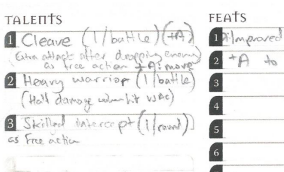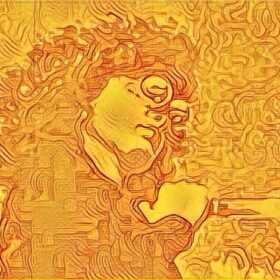 My original roleplaying group began 35 years ago. I received the AD&D Player’s Handbook and Dungeon Master’s Guide for my birthday, learned the game from there, and ran it for my friends. People left and joined the group, set in the same campaign, over the years, but none of them ever played in any other game group, and while they tried Traveller for a while, AD&D was it. I didn’t play with anyone I didn’t know until 2001, when we playtested the Dying Earth, and we formed a new game group.
My original roleplaying group began 35 years ago. I received the AD&D Player’s Handbook and Dungeon Master’s Guide for my birthday, learned the game from there, and ran it for my friends. People left and joined the group, set in the same campaign, over the years, but none of them ever played in any other game group, and while they tried Traveller for a while, AD&D was it. I didn’t play with anyone I didn’t know until 2001, when we playtested the Dying Earth, and we formed a new game group.
In 2007, after a break of many years, I met one of the old group and they asked to play the original game again, so every year we get together for a weekend to play with their original AD&D characters who have reached the giddy heights of 25th level or higher, destroy huge quantities of food and drink, hoot, yawp, mock and laugh – ThawCon
This year, one of the players, whose son is a big 13th Age fan suggested we play 13th Age instead. I was up for this, no problem, but some of my original group are quite conservative and sceptical, and so began a campaign or gradual persuasion. “Do we still roll d20s to hit?” “Yes.” “If we roll a 20, do special things happen?” “Yes” After a bit of back-and-forth, they agreed to try a single session. I said we could switch back to the original campaign if they weren’t enjoying it.
This is how I gently lured them into it.
The original email pitch:
13th Age
13th Age is a D&D-like game set in the current campaign world. Your existing characters get to be Icons of that eg The God Assassin, The Viridian Mage, The Dark King, The Wizard of the Interstices, The Renowned Illusionist, An Awesome Name For Whoever the Hell Chris Currently Is, plus some major NPCs.
Your new characters have an indirect relationship with one or more of these Icons (you really, really wouldn’t want to actually meet any of them) which can be positive, negative or conflicted. You can make an Icon roll to call upon the knowledge, resources or network of the icon.
It’s AD&D, but with extra options. If you think of how your magic items currently work (especially Andrew’s sword) the characters work like that. So you get multiple choices for you actions which can sometime trigger off die rolls – so 20s can be awesome for example, but every class is different. You can always do a basic attack (what you currently do).
Some are complex to play – some are very simple – all are equally powerful. I am running it for the first time next week to see how it plays
out.
Character classes, increasing order of complexity. I’ve played a wizard, and it’s about as complex and has as many options as playing say an 8th level AD&D Wizard. I can give recommendations to suit players. I’ve asked Rob Heinsoo, designer of the game and of the previous version of D&D to come up with an Assassin class or bolt-on if anyone wants one George?
[I described each class here, and did recommendations]
Advantages: familiar background, familiar premise, familiar setting, roll d20 to hit and get extra stuff happening on high rolls, reasonably familiar rules, quick combat, characters have lots of choices even at low levels, can survive without a cleric, Steve and Chris know it. I can link the narrative into the main game. Rapid and incremental level advancement (eg you can select a feature of the next level up every now and then). Suits large parties.
Disadvantages: I’m not so familiar with it, requires more effort on my part (don’t mind), it will require some brain work from you to work to learn and take advantage of all the options. Linking to the other campaign might put your new characters in the shadow of the old ones.
I sent them the PDFs, and the details of the One Unique Thing and background and the following reading instructions. You might be able to tell they are quite combat-oriented.
The book is big, but you can miss most of it. Much of it is background specific to the game, which we won’t be using.
The glossary/index is pretty good.
I’d suggest you start with combat, page 159-174.
Then read p29-31 for the character creation overview.
Classes – read p 74-75 then scan through the ones you are interested in. There is all sorts of info elsewhere in the book about feats and all that sort of stuff, but most of it is repeated in each class.
Races follow on from class choice.
I set the game 15 years in the future from the AD&D campaign. This was short enough for familiarity, but distant enough to allow me to make changes.
There original characters had gone missing ten years ago, accused of regicide. I gave them the option of using their original characters as their icons (you couldn’t chose your own character as an icon). This gave them a link to their characters, without their new characters being dominated by the old ones (dealing with the disadvantage I mentioned above).
Characters
I recommended each of them a class. The most difficult choice was for George, the eponymous Thaw of ThawCon, our host. Originally, I spoke to Rob Heinsoo about doing an assassin character or bolt-on power. He came up with some good ideas, but in the end George (with assistance from Steve Dempsey) built a horribly min-maxed paladin, Gilfyn, with backgrounds which added assassin-like stealth. His Smite is terrifying, and his chose a form of synaesthesia as his One Unique Thing – to see lies and evasions as a cloudy emission. (I treated this like Bullshit Detector in GUMSHOE). He rolled his stats, and his reputation for incredible rolls from previous years continues. He ended up with a 19 Charisma and a couple of other top stats.
 To Mark Fulford (of ProFantasy and Noteboard fame) I suggested a wizard. I said “To be the destroyer wizard, choose Evocation and High Arcana as class talents, then throw Acid Arrow (40 damage for an individual) or Shocking Grasp (18 damage for a group). At third level use Force Salvo (40) and Lightning Bolt (56).”
To Mark Fulford (of ProFantasy and Noteboard fame) I suggested a wizard. I said “To be the destroyer wizard, choose Evocation and High Arcana as class talents, then throw Acid Arrow (40 damage for an individual) or Shocking Grasp (18 damage for a group). At third level use Force Salvo (40) and Lightning Bolt (56).”
That picqued his interest. He replied the next day “An evoked meteor swarm in a small space does 160 minimum, 640 maximum on 1 to 4 targets. My kind of spell.” Sold. He decided to roll for stats, which I witnessed over Google+. So Coyote was born – a former slave – and character from the subconscious mind of Tarantino, who sees everything in filmic terms and has a soundtrack. Mark figured out quite how powerful the Wood Elf racial ability is (the potential to earn extra actions), so he took that.
John Scott I know loves his gothic horror. What better than a Necromancer? To prevent him being just unpleasant, he took the Redeemer feature, which meant that his undead minions, when slain, exploded i n burst of holy energy and went to a bad place. He decided to roll his stats, and got the very worst results I have ever seen in a character (in AD&D I do 4d6 relroll 1’s and one stat must be 15 or higher). He got a 6, an 8, and no other stat above 12. Luckily, the Necromancer can take advantage of a very low Constitution using a feat. Beremondo’s mother gave birth while a vampire was feasting on her. Interrupted by his true father, then vampire fled. His mother died, and while his father funded his way through college, he would not speak to him.
Chris Godden, with the help of his son Jay, built another assassin based on the rogue, Zati. He used the point-buy option for his stats to ensure he got exactly what he wanted. This is a second character whose mother died, this time under mysterious circumstances, possibly assassinated by a rival faction. with an inexplicably good sense of smell. Drow cruelty suited this PC.
Andrew Burnford I thought would suit a fighter or commander. I was nervous about the fighter as a fit for Andrew because of flexible attack options at 1st level, and that the damage to start with appears mediocre compared with the paladin, particulary a min-maxed one. Histill was a former Master of Fireworks for the King, and with an incredible display he unwittlingly provided cover for the regicide. Andrew rolled for stats, too, despite our best advice, and did not do well. His One Unique Thing has not yet come into play, and I’d best not mention it.
Steve Dempsey, an experienced player, rolled for stats and built a cleric, Sythiros, happy to boost others power subtly, while not dishing out too much damage himself. He is a Keeper of Dead Knowledge and became a cleric when a dying woman whispered his like to him. He took the Knowledge, Death and Anti-Undead domains. He works with the Necromancer only because the Necromancer is a redeemer of the dead.
So how did it go? Tune in next time…
Next Time: Preparing for and Running 13th Age for the new GM



 out.
out.